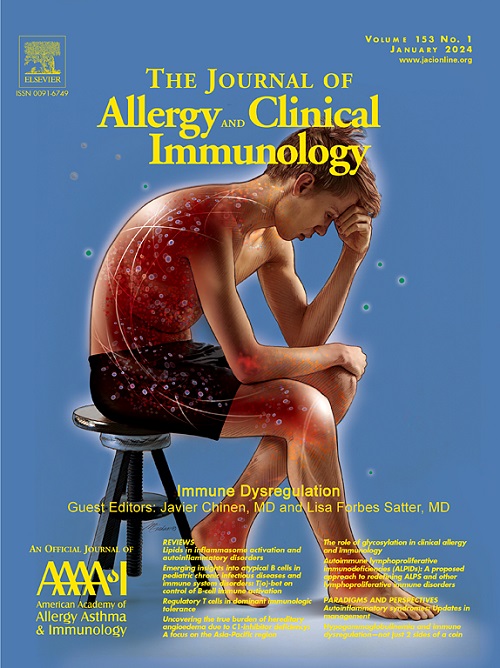APE1氧化还原功能在慢性鼻窦炎发病机制中的作用:靶向治疗的意义。
IF 11.2
1区 医学
Q1 ALLERGY
引用次数: 0
摘要
无尿嘧啶/无嘧啶核酸内切酶1 (APE1)是一种多功能酶,具有两种不同的功能-在其c端区域的内切酶活性和在其n端区域的氧化还原功能。APE1的氧化还原活性调节了参与细胞存活、血管生成和炎症的转录因子子集。然而,其在慢性鼻窦炎伴鼻息肉(CRSwNP)中的作用尚不完全清楚。目的阐明APE1氧化还原功能在CRS发病机制中的作用,并评价以APE1为靶点的氧化还原抑制剂的治疗潜力。方法采用单细胞RNA测序、免疫组织化学、Western blot和RT-qPCR检测sape1在人鼻组织中的表达和功能。采用CRS小鼠模型、气液干扰(ALI)培养的人鼻上皮细胞(HNECs)和Beas-2b细胞,研究APE1氧化还原抑制剂对2型免疫应答、黏液高分泌、上皮屏障破坏和氧化应激的影响。结果ape1在CRSwNP患者中高表达,其表达上调与嗜酸性粒细胞浸润、粘液分泌增多、上皮损伤和氧化应激密切相关。在CRS小鼠模型和ali培养的HNECs中,C10对APE1氧化还原功能的药理抑制显著降低了簇状细胞中IL-25的产生,并降低了2型细胞因子(IL-4、IL-5、IL-13)的水平,同时降低了Th2和ILC2细胞的浸润。转录组分析和体外实验表明,靶向APE1可有效减轻活性氧的产生、氧化应激失衡和线粒体损伤。结论研究结果强调了APE1氧化还原功能在CRS病理生理中的潜在作用,特别是在驱动2型炎症、线粒体氧化应激、粘液产生和上皮屏障功能障碍方面。APE1氧化还原抑制剂C10可有效阻断2型炎症,改善CRS病理,提示其治疗CRS的潜力。本文章由计算机程序翻译,如有差异,请以英文原文为准。
Role of APE1 redox function in chronic rhinosinusitis pathogenesis: Implications for targeted therapy
Background
APE1 is a multifunctional enzyme with 2 distinct functions—endonuclease activity in its C-terminal domain and redox function in its N-terminal domain. The redox activity of APE1 regulates a subset of transcription factors involved in cell survival, angiogenesis, and inflammation. However, its role in chronic rhinosinusitis (CRS) with nasal polyps is not fully understood.
Objective
We sought to elucidate the role of APE1 redox function in the pathogenesis of CRS and to evaluate the therapeutic potential of targeting APE1 with redox inhibitors.
Methods
APE1 expression and function were assessed in human nasal tissues using single-cell RNA sequencing, immunohistochemistry, Western blot, and quantitative RT-PCR. CRS mouse model, air-liquid interface–cultured human nasal epithelial cells, and BEAS-2B cells were used to examine the impact of the APE1 redox inhibitor on type 2 immune responses, mucus hypersecretion, epithelial barrier disruption, and oxidative stress.
Results
APE1 is highly expressed in patients with CRS with nasal polyps, and this upregulation was closely associated with eosinophil infiltration, mucus hypersecretion, epithelial damage, and oxidative stress. In the CRS mouse model and air-liquid interface–cultured human nasal epithelial cells, pharmacologic inhibition of APE1 redox function by C10 markedly reduced IL-25 production in tuft cells and decreased levels of type 2 cytokines (IL-4, IL-5, IL-13) along with TH2 cell and group 2 innate lymphoid cell infiltration. Transcriptome analysis and in vitro experiments demonstrate that targeting APE1 effectively mitigates reactive oxygen species generation, oxidative stress imbalance, and mitochondrial damage.
Conclusion
The findings underscore the potential role of APE1 redox function in CRS pathophysiology, particularly in driving type 2 inflammation, mitochondrial oxidative stress, mucus production, and epithelial barrier dysfunction. The APE1 redox inhibitor, C10, effectively blocked type 2 inflammation and improved CRS pathology, suggesting its therapeutic potential for CRS treatment.
求助全文
通过发布文献求助,成功后即可免费获取论文全文。
去求助
来源期刊
CiteScore
25.90
自引率
7.70%
发文量
1302
审稿时长
38 days
期刊介绍:
The Journal of Allergy and Clinical Immunology is a prestigious publication that features groundbreaking research in the fields of Allergy, Asthma, and Immunology. This influential journal publishes high-impact research papers that explore various topics, including asthma, food allergy, allergic rhinitis, atopic dermatitis, primary immune deficiencies, occupational and environmental allergy, and other allergic and immunologic diseases. The articles not only report on clinical trials and mechanistic studies but also provide insights into novel therapies, underlying mechanisms, and important discoveries that contribute to our understanding of these diseases. By sharing this valuable information, the journal aims to enhance the diagnosis and management of patients in the future.

 求助内容:
求助内容: 应助结果提醒方式:
应助结果提醒方式:


